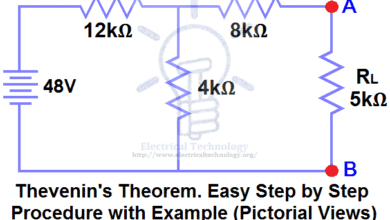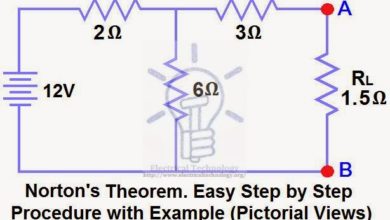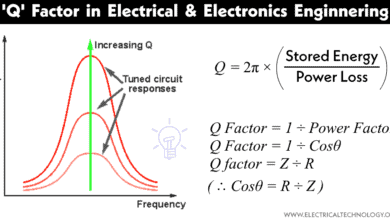Questions – Answers
Electrical and Electronics Engineering Interview Questions and Answers
-
Norton’s Theorem. Easy Step by Step Procedure with Example
Norton’s Theorem in DC Circuit Analysis Norton’s theorem is another useful technique to analyze electric circuits like using the Thevenin’s Theorem, which reduces linear, active circuits and complex networks into…
Read More » -

Thevenin’s Theorem. Step by Step Procedure with Solved Example
Thevenin’s Theorem in DC Circuit Analysis A French engineer, M.L Thevenin, made one of these quantum leaps in 1893. Thevenin’s Theorem (also known as Helmholtz–Thévenin Theorem) is not by itself an analysis…
Read More » -
What is an Electric Circuit? Types of Circuits and Network
Electric Circuit, Network, Complex Circuits and other Types of Circuits What is an Electric Circuit? An electric circuit is a closed loop network which provides a return path for the…
Read More » -
Difference Between Unilateral and Bilateral Circuits and Elements
What is the Difference Between Unilateral and Bilateral Circuits and Elements? Unilateral and bilateral circuits are two types of electrical circuits that have different characteristics. Both types of circuits can…
Read More » -
How to Determine the Number of Nodes, Loops, Branches & Meshes in a Circuit?
What is Node, Branch, Loop and Mesh in an Electric Circuit, and How to Identify them? Understanding the fundamentals of electric circuits and networks is crucial for solving and analyzing…
Read More » -
Difference Between Linear and Nonlinear Circuits and Elements
What is the Difference Between Linear and Nonlinear Circuits Linear and nonlinear circuits are two different types of electrical systems. In this article, we are going to describe the key…
Read More » -
Efficiency of Transformer – All Day Efficiency & Maximum Efficiency
Transformer’s Efficiency: All Day Efficiency & Condition for Maximum Efficiency Efficiency of Transformer Similar to other electrical machines, (e.g. motors, alternator/generators etc.) the transformer’s efficiency on specific load and power…
Read More » -
Series, Parallel and Series-Parallel Connection of Batteries
Series, Parallel & Series-Parallel Configuration of Batteries Introduction to Batteries Connections One may think what is the purpose of series, parallel or series-parallel connections of batteries or which is the…
Read More » -
Q Factor in Electrical and Electronics Engineering
What is the ‘Q’ factor in Electrical and Electronics Engineering? Q Factor In a tuned circuit, the ratio between reactance and resistance is called the Q Factor or Quality Factor.…
Read More » -
How to Calculate the Suitable Capacitor Size in µ-Farads & kVAR for P.F Improvement
How to Find the Right Size Capacitor Bank Value in both kVAR and Microfarads for Power Factor Correction – 3 Methods As we got lots of emails and messages from…
Read More »








